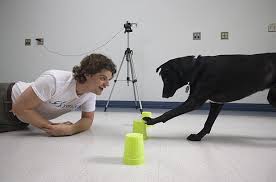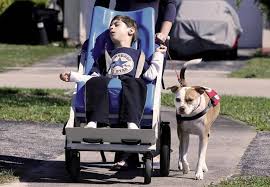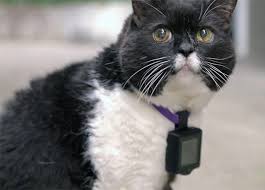Is Your Dog A Genius?
Dr. Brian Hare - NAT GEO WILD
 Nat Geo's Dr. Brian Hare is hosting a three-part series devoted to finding the genius in your dog with interactive games you can play. Tapping into your dog's 'smarts' is easy as knowing the activities in which they exceed.
Nat Geo's Dr. Brian Hare is hosting a three-part series devoted to finding the genius in your dog with interactive games you can play. Tapping into your dog's 'smarts' is easy as knowing the activities in which they exceed.
Dr. Brian Hare, founder of the Duke Canine Cognition Center, is the host of the new NAT GEO WILD Show, "Is Your Dog A Genius?"
Dogs live in your home. They know your most intimate secrets. They know your smell! But how well do you know that stranger sleeping in your bed? Dr. Brian Hare has spent his life tracking down clues to the remarkable bond between humans and canines. Now he's developed a groundbreaking series of scientific tests to see just how well you know your dog.
The great and fun thing about this show is that it has a participatory component. With most TV show, you watch and learn and that's it. But this new show on NAT GEO WILD, "Is Your Dog A Genius?" will allow you to not only see the best science and learn what the best science reveals about dogs, but will also tell you how you apply it to your own dog at home. This is not homework, but fun and games which will allow you to have an even better relationship with your dog and understand how they think.
Are there certain dogs that are smarter than others? Are there certain dog breeds as a whole, which are smarter than other breeds? These questions are why NAT Geo decided to do this show. If everyone who has a dog watches this show and in return participates, then people with different dog breeds will contribute data that will allow these questions to be answered.
 This show is not about whether or not dogs are smart, but to reveal what science has shown, which is that there is different type of intelligence in dogs and different dogs have different ways of solving problems.
This show is not about whether or not dogs are smart, but to reveal what science has shown, which is that there is different type of intelligence in dogs and different dogs have different ways of solving problems.
On the show, you will see dogs that are incredible communicators; dogs that have amazing empathy; and even dogs that are capable of inference. However, it doesn't mean that each individual dog does all these three things.
One thing that was recently learned about dogs is that just like human infants, dogs when they lock gaze with us, are actually releasing the same hormone that leads to bonding between a human and infant when a baby is first born. This is interesting, because we have all heard that making eye contact with dogs is threatening to them.
The three part series of "Is Your Dog A Genius" airs on NAT GEO WILD on:
Friday, May 15: Talk Doggy To Me
Saturday, May 16: Doggy See, Doggy Do
Sunday, May 17: Who's Your Doggy?
Check your local listing for times.
http://natgeotv.com/za/is-your-dog-a-genius
Play With Animals From Anywhere In the World
Scott Harris - iPetCompanion Homeplay
 Scott Harris co-invented a cat feather-toy that can be remotely controlled from a smartphone. They've installed 21 of these toys at shelters nationwide. With a click of a button, you too can play with the animals up for adoption - from the comfort of your own armchair.
Scott Harris co-invented a cat feather-toy that can be remotely controlled from a smartphone. They've installed 21 of these toys at shelters nationwide. With a click of a button, you too can play with the animals up for adoption - from the comfort of your own armchair.
Scott Harris is the founder of iPetCompanion Homeplay, which is a web-based remote play system that allows people to physically play with animals in shelters in real time while at work, traveling, at college, or anywhere there is an Internet connection.
The toy you play with is an actual real toy. There is no animation or anything virtual, it is actually happening in real time. For example, no matter where you are in the world as long as you have an Internet connection, you push the button on the screen, where there is a real physical toy that moves inside the shelter, allowing you to play with the animals in real time.
If you don't have the time to go to a shelter and help out, this gives you a way to interact with and break up the day of an animal. The iPetCompanion Homeplay allows anyone to control any physical object they want to move from anywhere in the world.
Since iPetCompanion Homeplay began, the shelters have seen:
 • Up to an 18% increase in kitten adoptions,
• Up to an 18% increase in kitten adoptions,
• Up to a 295-percent increase in sponsorships,
• Up to 52-percent sustained increase in overall web traffic,
• Online visitors from more than 170 countries logging in to play with adoptable animals, and
• Average viewer times of 28 minutes per site.
This technology is limitless. Can you imagine a doctor being able to help out during a surgery in another country? Or, how about being able to pour Gatorade or hand a towel from your armchair to your favorite player coming off the field?
This is also great for children (and adults) who are in hospitals and cant be around animals. This not only breaks up the day of the animal, but it also breaks up the day for the children.
These systems have previously been available only to humane societies and animal shelters, but, iPetCompanion Homeplay is in the process of creating a home version where you will be able to log on with your own personal webpage to physically control the iPet camera and toys directly from the screen. You'll be able to move the camera, zooming in to get a closer look at your pets, scan the room to see what your companion animals are doing, and even physically play with your pets at home by clicking a button and controlling remotely operated toys. Pet parents can also take photos of their animals for online scrapbooking, and can chat and share photos among friends, if they choose to allow page access to others.
http://www.ipetcompanion.com
 The Dogfather's Grooming Tip with Joey Villani
The Dogfather's Grooming Tip with Joey Villani
Micro-Bubble Machine
There is a new machine from Japan that's been around for five years, which is now being sold to groomers in the United States. It is called a Micro-Bubble Machine and it allows you to clean underneath the skin. Joey states that it's expensive but worth it!
Joey has talked to groomers in the United States who have tried this machine and asked them to do studies on it. He states that the study included about 100 dogs that had skin conditions such as elephant skin, leathery skin, or hair loss that wasn't growing back. All of these dogs were put on a regimen where they would go in once a week and use the machine. After a few months, 100-percent of the dogs were cured.
 Basically what the machine does is it breaks down the molecules so that they are smaller and then they are oxygenated. This allows it to get into the skin easier, allowing it to clean out all of the bacteria that you normally can't reach.
Basically what the machine does is it breaks down the molecules so that they are smaller and then they are oxygenated. This allows it to get into the skin easier, allowing it to clean out all of the bacteria that you normally can't reach.
Some of the dogs in the study had skin problems for over five years that no one could cure. But after just three months of weekly treatments, their skin turned completely back to normal, including new hair growth.
If you are a pet owner that has a dog with any kind of skin problem, you probably know that it's not very easy to cure. But now there's hope. Just ask your local groomer if they have a micro-bubble machine. About one out of every ten groomers currently own one of these machines.
 Its Not Doggie Asthma - It's a Reverse Sneeze -Dr. Debbie
Its Not Doggie Asthma - It's a Reverse Sneeze -Dr. Debbie
What dog owner hasn't heard that frightening sound that dogs make- part cough, part sneeze and often described as a dog being unable to catch his breath. But it really isn't asthma, or some kind of bone stuck in your dog's throat - it's a reverse sneeze. So before you panic and run into the veterinary office on emergency, ensure you know what a reverse sneeze is.
Meet the Reverse Sneeze
A reverse sneeze is a respiratory sound in a category all its own. Also known as a pharyngeal gag reflex or backwards sneeze, the reverse sneeze is a commonly observed respiratory sound in dogs, and less commonly in cats. While a true sneeze occurs on the exhale, the reverse sneeze occurs as the dog inhales. The result is a reverberating snorting, wheezing, episodic sound that lasts for a few seconds to a minute or two. A reverse sneeze is a completely harmless sound and dogs do not suffer any immediate health threat from these episodes.
How can you tell it's a reverse sneeze?
There is no easy explanation of the sound- you just have to hear it and you'll recognize it. Click to see and hear an example of a dog's reverse sneeze episode.
Part of my enjoyment on the weekly national radio program, Animal Radio®, is describing the peculiar smells, sounds and essences of veterinary medicine with our listeners. On many an occasion when speaking to callers, I have re-created the sounds of reverse sneezing. I'm no Rich Little, but I do take pride in my impersonation of a canine reverse sneeze, which is admittedly better in person with the visuals to complement the throaty sound.
Characteristics of a dog displaying a reverse sneeze include:
 -Vibrational coughing/wheezing sound
-Vibrational coughing/wheezing sound
- Stiff, extended neck
- Facial grimace
- No discharge from nose
- Not followed by coughing or vomiting up material
- Not involving collapse episodes
- Animal is completely normal after event
What causes a reverse sneeze?
Some reverse sneeze episodes occur when a dog gets very excited or pulls against a leash. Brachycephalic breeds (short faced breeds) like Pugs and Boston terriers commonly display reverse sneezing due to their upper airway conformation.
Allergies, respiratory infections, nasal mites, inhaled foreign bodies and masses can also trigger reverse sneezing. Dogs with inflammatory conditions such as lymphoplasmacytic rhinitis can also display bouts of reverse sneezing. And sometimes reverse sneezing occurs in the wee hours of the night, while a dog is sleeping, for no apparent reason. In fact, many veterinarians receive panicked phone calls at 2am from pet owners, concerned of impending asthma attacks or respiratory arrest, only to have it turn out just to be a typical case of reverse sneezing.
What to Do?
There is no required treatment for a reverse sneeze episode. However, I recommend stroking a dog's throat while gently speaking to him in a calm manner until the episode subsides. Some advocate closing/pinching the nostrils off, which forces a dog to swallow and curtails the reverse sneeze episode. Whatever the approach, reverse sneezing episodes are over within minutes, so no emergency treatment is indicated. Antihistamines may be prescribed to minimize reverse sneezing episodes.
When to Worry?
If all of a sudden your dog is having repeated bouts of reverse sneezing, evaluation by your veterinarian is indicated. Consult with your veterinarian if your dog is reverse sneezing along with other symptoms such as facial rubbing, nasal bleeding, nasal discharge, coughing, or significant sneezing episodes.
Nasal mites are a common cause of reverse sneezing and may be noted after a recent boarding visit, especially if multiple dogs in a household are involved. Nasal mite treatment is easily pursued with anti-parasite injections of ivermectin (or in collie breeds - the alternative Milbemycin.) If reverse sneezing is excessive and prolonged, the nasal and pharyngeal areas should be evaluated by a veterinarian through rhinoscopy - a procedure performed under anesthesia in which the nasal passages and pharyngeal areas are visualized with an endoscope, a micro camera. This is how foreign objects and masses are typically identified. In other cases, further tests may be needed including a CT scan or with biopsy samples from sinus passages.
Final Thought
The good news is that most of reverse sneezing episodes are harmless, and do not indicate any serious illness. Arm yourself with information by learning what a reverse sneeze looks like and you may save yourself an unwanted emergency veterinary visit over this peculiar but non-life threatening occurrence.
Featured veterinarian known as "Dr. Debbie" on national pet radio program, Animal Radio. Ebook author of "Yorkshire Terriers: How to Be Your Dog's Best Friend"; "Pugs: How to Be Your Dog's Best Friend"; "Mini Schnauzers: How to Be Your Dog's Best Friend"; and "Shih Tzu: How to Be Your Dog's Best Friend."
http://www.drdebbie
It's a Wacky Wednesday Here at the Animal Radio® Studios
WackyWed Contest IS ON - LIKE your FAVORITE pic and the three pics with the most LIKES & SHARES are this week's winner will receive a GPS Pet Tracker from Tractive.
 TO ENTER Send us your FUNNY pet pic to WackyWed@AnimalRadio.com - (Please put WACKYWED in the subject line & give us your pet's name, your name & where you hail from) If YOUR pic is chosen then spread the word to your friends & family on Wednesday - the pics w/the most LIKES and SHARES will be the winner!
TO ENTER Send us your FUNNY pet pic to WackyWed@AnimalRadio.com - (Please put WACKYWED in the subject line & give us your pet's name, your name & where you hail from) If YOUR pic is chosen then spread the word to your friends & family on Wednesday - the pics w/the most LIKES and SHARES will be the winner!
This week we are giving away a GPS Pet Tracker that helps pet owners locate their dog, cat or any other pet, from Tractive, which allows the user to track a pet in real-time letting pet owners follow every step of their beloved friend.
The Tractive GPS Pet Tracker is very robust and 100% waterproof - therefore, suitable for any kind of weather.

Join Animal Radio® on Facebook for Wacky Wednesday! Win great prizes every week for your wacky pet pictures. Last month we gave out goodies from Wham-O Inc., BH Pet Gear, Dream Bones, Oster and more. Visit us on Facebook now.
 Animal Radio® News - Tammy Trujillo
Animal Radio® News - Tammy Trujillo
It's Not Our Fault That We Consider Our Pets Our 'Babies'
A new study sheds some light on why our emotional attachment can be so strong with our pets. Research done at the Azabu University in Japan says the connection is comparable to the actual bonding between a parent and infant. It has to do with the hormone called oxytocin, or the cuddle chemical. It's produced in the brain and encourages bonding. Previous studies show it works human-to-human and even dog-to-dog, but this study is the first to show the hormonal bonding between people and dogs. In the study, pet guardians and their dogs gazed at one another resulting in increased oxytocin. In the second part, researchers dosed dogs with either a spray of saline or oxytocin in the nose. The female dogs treated with oxytocin spent more time gazing at their guardians, which after 30 minutes boosted the levels of their peoples' oxytocin.
 Service Pit Bull Allowed to Attend School
Service Pit Bull Allowed to Attend School
This is a big win for the rights of service animals and for the people who rely on them so very much. A federal judge in Florida has ruled that a sweet pit bull name Stevie will be allowed to go to school with 7-year-old Anthony Alboniga, who has cerebral palsy. Stevie does a lot of things for Anthony, like alert a grown-up when something is wrong and just keeping him company and comforting him. For the past two years though, officials at Anthony's school in Broward County refused to let Stevie come to school with Anthony, unless the company paid for a so-called handler to go with them, which the family could not afford. After a long legal battle, U.S. District Judge Beth Bloom sided with Stevie and Anthony. Under the Americans with Disabilities Act, schools aren't allowed to separate people from their service animals. The ruling in Stevie and Anthony's case could set a precedent when other schools challenge that rule.
Medical Marijuana For Pets Is Now Available In Texas
You have to go online, but you can buy capsules, treats and other marijuana edibles as natural pain relievers for your pets in Texas. Because they contain such a low percentage of THC, the chemical responsible for most of marijuana's psychological effects, they're legal. Veterinarians cannot prescribe cannabis products to pets, they can only recommend them. At least one veterinarian has spoken out about the issue, saying there is no proof that medical marijuana can help pets and no research on whether it can harm them. He says the biggest concern is that the availability of medical marijuana for pets amounts to them being used as guinea pigs. The FDA is investigating the benefits of the products.
 Chimps Get Their Day In Court
Chimps Get Their Day In Court
Two chimpanzees will have their day in court under a law that up until now has only applied to people. New York Supreme Court justice Barbara Jaffee has granted Hercules and Leo a writ of habeas corpus. They live in a lab at Stony Brook University of Long Island and have been part of research into how humans evolved to walk on two legs. They're being represented by the Nonhuman Rights Project, which has been trying to get chimps the rights of personhood for years. In its petition, it claims the research animals Hercules and Leo are being "unlawfully detained" and demand their immediate release and transfer to the Save the Chimps animal sanctuary in Florida. A representative for Stony Brook had to appear in court to provide a legal rationale for keeping Hercules and Leo. It's possible the ruling will state that researchers have every right to keep using the chimps in their lab. Even if that does happen, the NHRP says it's a big step forward to "getting the right to bodily liberty for chimpanzees and other cognitively complex animals."
San Francisco Bans Wild and Exotic Animal Acts
When the circus comes to San Francisco next time around, it won't feature any wild or exotic animal acts. San Francisco is the latest city to ban such animals from performing. The ban any covers exotic animals used in entertainment, everything from elephants and lions to seals and ferrets and applies to more than just circuses. It includes the motion picture industry, meaning no films made in San Francisco can feature wild animals. Other major cities across the U.S. have passed laws that effectively keep exotic animals out of circuses. Los Angeles, Austin and Oakland have banned the use of bull hooks, or sharp metal sticks used to control elephants, which are needed to coerce elephants into performing. And in other countries, Austria, Croatia, Greece, Malta are among those that have all passed nationwide bans on performing exotic animals in circuses.
 Catsacam Allows Your Cat To Post Its Own Pics on Instagram
Catsacam Allows Your Cat To Post Its Own Pics on Instagram
Many pets have their own Facebook pages and Twitter accounts. Of course there's a person behind them doing the work. Not for long. Whiskas Australia have created a wearable camera that goes on your kitty's collar and it automatically takes pictures and posts them to Instagram for you and your cat. The Whiskas Catsacam uses a motion detector to take pictures every 20-seconds from the cat's point of view. Right now it's a promo campaign by cat food brand Whiskas in Australia and the cameras are being given to celebrity cat owners, or "famous" cats. There are also only a limited number of Catstacams in existence. But information about them has started burning up the Internet, so we can only hope, and expect, that they will be made available to the rest of us sometime in the near future.

NEWS UPDATE brought to you by Drs. Foster & Smith, affordable pet supplies. Low prices every day, so you save on every order.
 Listen to the entire Podcast of this show (#805)
Listen to the entire Podcast of this show (#805)





